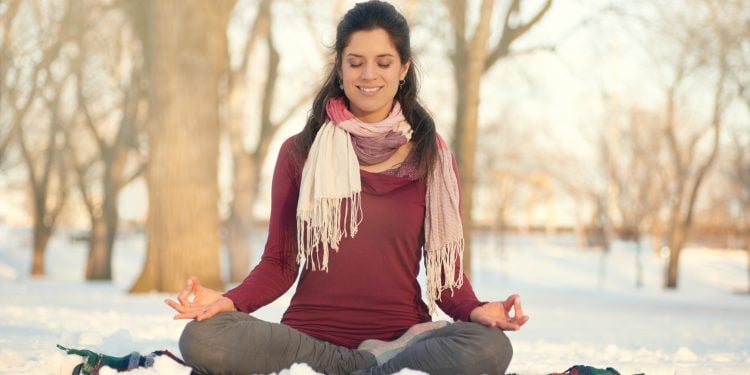The holiday season is supposed to be a time for joy, peace, love and caring for one another. However, stress is often times a big component as people flock to the mall to find the perfect gift, agonize over cooking a perfect holiday meal and worry about entertaining family and friends. To manage stress effectively this holiday season it is important to remember that perception is under your control. Modifying your thought processes is a powerful tool to help you manage unwanted stress. Modifying thought processes typically involve relaxation techniques which include muscle-to-mind or mind-to-muscle techniques.
You can learn additional concepts and ideas within the NASM Wellness Coach Certification Course.
Muscle-to-Mind Techniques
Two common muscle-to-mind techniques include (1):
- Progressive muscle relaxation
- Massage
Progressive Muscle Relaxation
Progressive muscle relaxation teaches you to relax your muscles through a two-step process. The first step is to deliberately apply tension to certain muscle groups. Step two is to then remove the tension and focus your attention to how your muscles relax as the tension dissipates. Through repetitive practice you’ll quickly learn to distinguish between a tense and completely relaxed muscle. With this newfound knowledge, you can then implement muscular relaxation at the first signs of tension that accompanies stress and anxiety. And with physical relaxation comes mental calmness in any situation, even the holidays.
To perform progressive muscle relaxation, lay on your back on the floor, stretching out comfortably, with a pillow underneath your knees. Starting with your feet and working progressively upwards towards your head, contract your muscles in each region for five seconds with 70 percent maximal effort. Do not contract at 100% to avoid overstraining. For example, contract your feet for five seconds (70% effort), relax for a few seconds before progressing to your calves, quadriceps and hamstrings, gluteals and so forth. You can either choose to contract your muscles in a bilateral (i.e., both thighs simultaneously) or unilateral (i.e., right thigh followed by left thigh) fashion. Because stress tends to lead to high muscular tension, kinesthetic awareness of how tightening and relaxing your muscles feels can release tension and teach your body to relax (1).
Massage
Massage is another useful tool to alleviate unwanted tension within muscles and alleviate stress. Massage involves a systematic process of alleviating unwanted knots and trigger points (tender spots) reducing muscular tension and pain. Massage involves manipulating a person’s body with pressure, tension, motion, or vibration done manually or with mechanical devices. Target tissues usually include muscles and connective tissue such as tendons and fascia. Massage can be applied with the hands, fingers, elbows, and feet. Medical research has shown that the benefits of massage include pain relief, reduced anxiety and depression, and temporarily reduced blood pressure, heart rate, and state anxiety (2, 3).
Mind-to-Muscle
Some examples of mind-to-muscle techniques include (1):
- Yoga
- Meditation
- Visual imagery
Yoga
Yoga can be an excellent form of exercise to help manage stress over the holidays. The ultimate goal of yoga is to reach complete peacefulness of body and mind, helping you relax, and manage stress and anxiety. Traditional yoga philosophy requires that students adhere to this mission through behavior, diet and meditation.
In Western countries, many people are familiar mainly with the exercise portion of yoga, usually Hatha yoga. This style of yoga is designed to encourage a calmer mind, along with improved flexibility and muscular endurance. This system uses several positions and postures (“asanas”) to increase mobility and flexibility and may assist in reducing low-back pain if ideal posture and biomechanics is observed (4). In addition, the exercises involve deep diaphragmatic (belly) breathing techniques used to alleviate stress, and lower blood pressure and resting heart rate (1, 5).
Meditation
Mediation is a mind-focusing exercise used to control one’s attention, than can bring about emotional and physical benefits (6). Regular meditation has been shown to decrease heart rate, blood pressure, stress, anger and muscular tension (6, 7). This technique can be learned quickly but takes time and consistency to reap the benefits. When learning how to meditate it is important to pick a location that is quiet and away from distractions such as family, phones and televisions. As with most mind-to-muscle techniques deep diaphragmatic breathing is recommended.
Visual Imagery
Visual or mental imagery has been used as a healing technique for centuries in various cultures around the world. Visual imagery involves creating relaxing visual images and scenes such as a sunny beach or beautiful meadow in times of stress to elicit body and mind relaxation. As with other stress management techniques, imagery should be performed in a quiet and comfortable environment. Place yourself into the scene and visualize moving about and experiencing nature to its fullest, enjoying the animals, smells, and sounds. After 10 to 20 minutes you should feel considerably more relaxed and ready to tackle your holiday chores (1).
References
1. Hoeger SA, Hoeger WK. Lifetime Physical Fitness and Wellness A Personalized Program. 9th ed. Belmont: Thomson Wadsworth; 2007.
2. McPherson F, McGraw L. Treating generalized anxiety disorder using complementary and alternative medicine. Altern Ther Health Med. 2013 Sep-Oct;19(5):45-50.
3. Nyer M, Doorley J, Durham K, Yeung AS, Freeman MP, Mischoulon D. What is the Role of Alternative Treatments in Late-life Depression? Psychiatr Clin North Am. 2013 Dec;36(4):577-96. doi: 10.1016/j.psc.2013.08.012. Epub 2013 Oct 6.
4. Holtzman S, Beggs RT. Yoga for chronic low back pain: a meta-analysis of randomized controlled trials. Pain Res Manag. 2013 Sep-Oct;18(5):267-72. Epub 2013 Jul 26.
5. La Forge R. Mindful Exercise for Fitness Professionals. In: Howley E, Franks B, eds. Fitness Professional's Handbook. 5th ed. Champaign: Human Kinetics; 2007.
6. Orme-Johnson DW, Barnes VA. Effects of the Transcendental Meditation Technique on Trait Anxiety: A Meta-Analysis of Randomized Controlled Trials. J Altern Complement Med. 2013 Oct 9.
7. Bodian S. Meditate your way to much better health. Bottom Line Health; 2004:11-13.
















